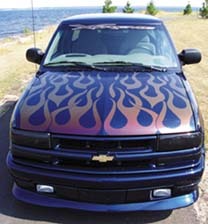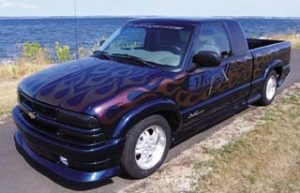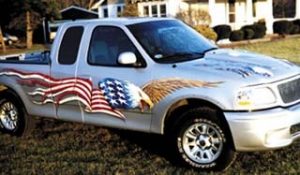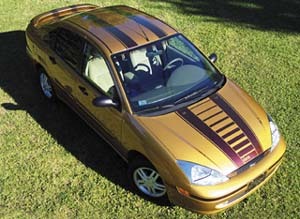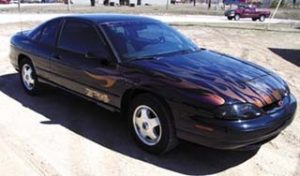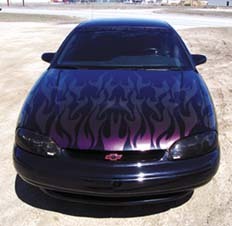However, McIntyre first cut it in paper — a more economical substrate than additional vinyl. He placed these paper flames on each truck section to ensure design compatibility.
After making a few design modifications, McIntyre cut the design into the Shadeshifter vinyl. He and a friend predominantly dry installed the flame graphics. He used application fluid only for installation on the truck’s front quarter panels.
"The hood curves down and out, so it’s like trying to put a piece of vinyl onto a ball," McIntyre says.
He advocates dry installation whenever possible: "I’m in a cold climate, and most of my customers want their vehicles shortly after the graphics installation. If I do a wet application, and they take the car out in the cold weather immediately, the application fluid could freeze and ruin the vinyl.
Bird’s Eye View
You don’t need an eagle eye to realize that airbrushing a job like this one for Truck Stuff (New Castle, PA) is a complex, arduous task. Even single elements, such as the eagle mural on the F150’s tailgate, require extensive detail work.
To begin the eagle, Steve Chaszeyka, Wizard Graphics (New Middletown, OH), removed the trim pieces from the truck. After removing all wax and grease using Prep Sol, he wiped away any remaining film with Windex.
Once the eagle was projected onto the tailgate and traced, he covered it with premask, and began painting the background with Speis Hecker paint. When the background was finished, Chaszeyka masked it off and uncovered the eagle. By following this procedure, he was left with a clean outline.
He painted the eagle’s feathers by first laying down darker gray values, then building lighter values and eventually, into white. This same dark-to-light approach was used to paint the brown and yellow beak. Black and maroon colors were airbrushed to create beak shadowing and outlines. Chaszeyka only opted for straight black on the eyeball and nostril.
"Don’t get carried away and start outlining everything [with black]!" he advises. "This is not a cartoon!"
Once he completed all airbrush work, Chaszeyka hired Catz Automotive to apply a coat of Speis Hecker clear. "I find that by paying someone to clear this type of work for me, I am free to do what I am best at," he says. "Also, I stink at clearcoating and rubbing it out, so I’d rather let the pros handle it. It lets me feel more like an artist."
Stripe Tease
What could have been standard racing stripes on this Ford Focus were given extra pizzazz by using Avery Dennison Shadeshifter magenta-to-gold vinyl. Even more unique, however, was the way in which Tim McIntyre, Stripe FX, continued the striped design onto the windows themselves by using window-tinting film.
"Cutting window-tint film on a plotter is a totally different setup than cutting regular vinyl," he reports. "To cut window-tint film, you have to use a swivel-knife in the plotter and lighten up the pressure that’s applied. Adjusting the pressure is the biggest thing. You have to get it right, because if you cut window tint too deeply, you’ll cut through its clear backer."
Although McIntyre prefers to apply vinyl using a dry technique, window-tint film must be applied wet. So, after installing the vinyl striping onto the car’s trunk and roof, he used a grease pencil and ruler to draw lines on the window’s exterior, which he used for alignment purposes.
After cleaning the inside of the window, he applied the window-tinting film. Once it was squeegeed in place, he cleaned off the grease pencil guidelines.
Car Rage Under Fire
Tim McIntyre, Stripe FX, boasts a unique work arrangement. Monday through Friday, he’s serves as a full-time employee of Meier Signs, a full-service electric signshop in Enscanaba, MI. But in the evenings and on weekends, he runs his own vinyl-sign business, which specializes in custom vehicle graphics. To keep overhead costs low, he designs on his home computer, but rents the use of Meier Signs’ cutting-plotter.
This black, ’99 Monte Carlo sports some of his custom flame designs, cut into Avery Dennison magenta-to-gold Shadeshifter vinyl. The flames are a hybrid of those he created for his own shop truck and "tribal" style flames, which he says are currently popular on imports.
Out of Africa
Typically, when a client requests "stripes" on a vehicle, he’s talking about pinstripes. This customer, however, asked Tim McIntyre, Stripe FX, for zebra stripes, like those he’d seen in photos of singer Ted Nugent’s Bronco.
Despite the price increase, the client gave him the go-ahead.
To develop a zebra pattern, McIntyre first purchased zebra-stripe fabric. But the pattern proved too repetitious to use.
So he opted for Plan B. He found a library book with a profile photo of a zebra, scanned it, blew it up, cleaned up the pattern and repeated it to create a truck design.
"A few things here and there had to be modified, but for the most part, I actually took the stripe design straight from one of mother nature’s creatures," McIntyre jokes.
In all, the black vinyl stripes required 12 hours of cutting, weeding and application.
"The client actually liked the finished result even better than Nugent’s Bronco. One thing’s certain: You can see him coming down the road!"
United We Drive
Since last September, countless Americans have proudly waved flags in front of their homes and businesses, sported lapel ribbons on their jackets, and even decorated their automobiles in patriotic red, white and blue. Vinny Orest, Crystal Graffix (Milton, VT) is no exception.
To decorate his 1986 black, 3/4-ton Chevy truck, Orest used Macmark 9800 s white and electric blue, as well as Macmark 8300 s red vinyl.
Installation proved challenging as Orest worked on this pet project little by little, over the course of three weeks. "Clients’ work comes first!" he explains.
"We turn a lot of heads with the flag truck," Orest continues. "It’s funny; people will call out ‘nice truck’ most anywhere we go.”


 Photo Gallery1 week ago
Photo Gallery1 week ago
 Ask Signs of the Times1 week ago
Ask Signs of the Times1 week ago
 Paula Fargo6 days ago
Paula Fargo6 days ago
 Real Deal3 days ago
Real Deal3 days ago
 Benchmarks2 weeks ago
Benchmarks2 weeks ago
 Photo Gallery6 days ago
Photo Gallery6 days ago
 Women in Signs1 week ago
Women in Signs1 week ago
 Women in Signs1 week ago
Women in Signs1 week ago
